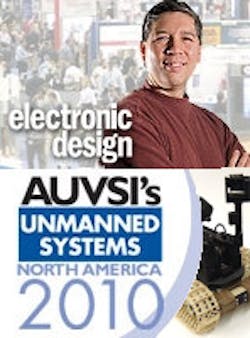AUVSI 2010 Coverage
Rockwell Collins
Hypertronics
Elma
Themis
AVEC
Z Microsystems
2d3
One thing that was very apparent this year is that unmanned vehicles are shipping in a big way. Platforms like General Atomics MQ-1 Predator are in the news (see "Fighting a real war in a virtual cockpit"). Smaller unmanned robots are in demand like QinetiQ’s Dragon Runner (see "QinetiQ’s Dragon Runner robots are sent to Afghanistan to support British troops") although there tends to be less coverage of these since they tend to save lives rather than lauch missles. Check out one of our Dragon Runner videos at EngineeringTV.com.
Last year I did Seaglider video that looked at one of iRobot's maritime platforms. This year I got to hear about how the Seaglider was used to track underwater oil plumes of the BP oil spill in the Gulf of Mexico (see Unmanned Seaglider undersea vehicles could cut through debates about underwater plumes and the quantity of oil spilled in Gulf of Mexico, Scientific American).
Single robots and unmanned vehicle use is still the norm but multiple robots and even swarms are becoming more common in research and eventually in the field. I had a number of chats with researchers as my alma mater, Georgia Tech, about their multitude of flying, swimming and rolling robots at AUVSI. You can check out the video interviews with Georgia Tech Research Institute researchers at EngineeringTV.com in the AUVSI 2010 section.
I also saw some impressive robots that will likely save lives in the air in the future. Rockwell Collins was showing how to keep a model aircraft flying even after it lost 80% of its right wing <(see Rockwell Collins reaches new heights in UAV damage tolerance flight testing). Of course, you have to check out our Rockwell Collins UAV Damage Tolerance video on this.
AUVSI was home to hundreds of robots but this year there were a lot of other vendors there with products that supported or used these robots. Many of these companies will be familiar to Electronic Design readers especially those interested VITA's OpenVPX specification that I recently wrote about (see OpenVPX Accelerates Military Time-To-Market). For example, Themis was showing off their Nano-ATR (on EngineeringTV.com) that has been proposed as a small form factor for VITA. I also did a video interview on the Elma Group's support for OpenVPX chassis.
Hypertronics was showing off their Hypertac connector technology. Of course we got a video with Jennifer St. Peters of Hypertronics too.
Managing all the video information coming from robotic systems is a challenge simply because of the amout for information being generated. I spoke with a number of vendors including Z Microsystems and 2d3 at AUVSI to check out their wares. In the Z Microsystems video you can check out the multiscreen management system for high flying UAVs. At the other end of the spectrum, the 2d3 video highlights how to manage a video database with geocoordinates. This platform targets users with a minimum of video processing expertise. Managing and processing all this information is almost more challenging from both a user and application developers perspective than the robotic hardware and software used to generate the content.
For those who are mechanically inclined, we did stop off at a few other booths showing some interesting engines and other mechanical technology. For example, Axial Vector Energy Corporation (AVEC) was showing off a new, lightweight, heavy fuel-burning, partially ceramic, 30 HP unmanned aerial vehicle (UAV) engine. Check out the AVEC video for a view of the engine in action.
I'll be writing up a few more of the many things I saw at AUVSI in the next few days so stay tuned. And definitely check out the videos that Curtis Ellzey and Terry Knight will be posting on EngineeringTV.com.
About the Author
William G. Wong
Senior Content Director - Electronic Design and Microwaves & RF
I am Editor of Electronic Design focusing on embedded, software, and systems. As Senior Content Director, I also manage Microwaves & RF and I work with a great team of editors to provide engineers, programmers, developers and technical managers with interesting and useful articles and videos on a regular basis. Check out our free newsletters to see the latest content.
You can send press releases for new products for possible coverage on the website. I am also interested in receiving contributed articles for publishing on our website. Use our template and send to me along with a signed release form.
Check out my blog, AltEmbedded on Electronic Design, as well as his latest articles on this site that are listed below.
You can visit my social media via these links:
- AltEmbedded on Electronic Design
- Bill Wong on Facebook
- @AltEmbedded on Twitter
- Bill Wong on LinkedIn
I earned a Bachelor of Electrical Engineering at the Georgia Institute of Technology and a Masters in Computer Science from Rutgers University. I still do a bit of programming using everything from C and C++ to Rust and Ada/SPARK. I do a bit of PHP programming for Drupal websites. I have posted a few Drupal modules.
I still get a hand on software and electronic hardware. Some of this can be found on our Kit Close-Up video series. You can also see me on many of our TechXchange Talk videos. I am interested in a range of projects from robotics to artificial intelligence.

